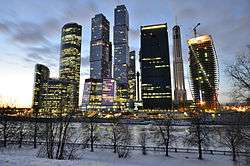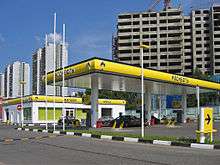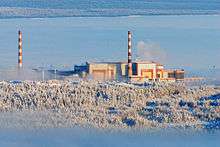Natural resources of Primorsky Krai
Primorsky Krai is a territory rich in natural resources:
Coal
More than 100 deposits of coal are known in Primorsky Krai. The commercial deposits of coal are connected to the Partizansky and Razdolnensky coal basins, the Podgorodnensky deposit, the Uglovsky basin, and the Shkotovsky, Pavlovsky, Bikinsky, Rettikhovsky, Suputinsky deposits.
The Partizansky Basin. The city of Partizansk is located in the southern part of the basin. The total area of the basin is 6,000 km2 (2,300 sq mi). The basin has been known since the 19th century and has been explored since 1902. Five coal-bearing regions - Staropartizansky, Melnikovsky, Belopadinsky, Molchanovsky, and Sergeyevsky - are within the limits of the basin. The coal is hard coal. By the output of the volatile substances and the caking ability rich coals prevail. The reserves of coal in the basin total 193.6 million tonnes. The deposits are maintained by the mines of the Partizanskugol Association. A Coal Mining Factory also operates in this area.
The Razdolnensky Basin. The total area of this basin is about 4,500 km2 (1,700 sq mi). The basin is located to the north and the west of the city of Ussuriysk. The basin includes the following deposits: Ussuriysky, Lipovetsky, Verkhne-Razdolnensky, Konstantinovsky, Alekseye-Nikolsky. The deposits were prospected as early as 1868. The mining of coal has been conducted since 1909. The coal is hard coal. By the output of the volatile substances and the caking ability long-flame coals prevail. The reserves of coal in the basin total 66.7 million tons. The deposits are maintained by the mines and the open-pit coal mines of the Lipovetskoye Mine Administration.
The Uglovsky Basin. Located 30 km (19 mi) to the north-east from Vladivostok. The basin's band extends about 40 km (25 mi) to the north-east of the Amursky Bay and ranges from 6 to 14 km (3.7 to 8.7 mi) in width. Coals in the basin have been known since 1859. The mining of coal has been executed since 1867 in the Tavrichansky deposit, and since 1911 - in the Artyomovsky deposit. The coal is brown coal, which is used as a power fuel. In the long years of operation the stocks of coal in the basin have been considerably depleted. The reserves of coal in the basin total 233.7 million tons. The mines of the Tavrichansky Mine Administration and the Artyomugol Association operate on the basis of the deposits.
The Podgrodnensko-Surazhevsky coal-bearing region is located close to Vladivostok. The stocks of the Podgrodnensky deposit are estimated to be a total of 19.6 million tons. The coal is hard coal. By the output of the volatile substances and the caking ability the coal is hard (non-bituminous). Maintained by the Podgorodenka mine of the Artyomugol Association.
The Paleogene-Neogene deposits of Primorsky Krai are the Bikinsky, Pavlovsky, Shkotovsky, Rettikhovsky, Rakovsky, and Khasansky deposits. The deposits are the major sources of fuel for the largest heat and power stations of Primorye - Luchegorskaya and Vladivostokskaya. The coal is brown coal.
The Bikinsky Deposit is the largest brown coal deposit in Primorsky Krai. Its total area is 260 km2 (100 sq mi). The reserves total 1,113.9 million tons. The coal-bearing thickness is 1,800 m (5,900 ft). The Luchegorsky Open-Pit Coal Mine maintains the mine and provides fuel to the largest power station in the krai - the Luchegorsky Hydro Electric Power Station.
The Pavlovsky Deposit. The total area is 400 km2 (150 sq mi). The reserves total 400 million tons. The coal-bearing thickness is up to 400 m (1,300 ft). The mining is maintained by the Pavlovsky-1 and Pavlovsky-2 Open-Pit Coal Mines. The coal is used as fuel for the Vladivostok Heat and Power Plant-2.
The Skotovsky Deposit. The total area is 150 km2 (58 sq mi). The reserves total 251.6 million tons. The coal-bearing thickness ranges from 800 to 950 m (2,620 to 3,120 ft). Maintenance is by the open-pit mine of the Artyomugol Association.
The coal of the Pavlovsky, Skotovsky, and Bikinsky deposits contains germanium and non-ferrous metals.
Tin
The major areas of occurrence of the commercial tin stocks are Kavalerovsky, Krasnoarmeysky, and Dalnegorsky Districts. There are more than 30 deposits of tin in Primorsky Krai. The extraction of tin ore is maintained by Khrustalnenskaya Tin Extracting Company, Dalpolimetal Stock Company, and Vostok Mining Company. All tin extracting enterprises of the krai are provided with a 30 years' ore supplies.
Tungsten
There are four major commercial deposits of tungsten in Krasnoarmeysky and Pozharsky Districts. The mining of only two of them is currently maintained: Vostok-2 and Lermontovskoye by the Primorsky Mining Group and Lermontovskoye Mining Company. The enterprises have a 10 years' reserve supply. The ores are complex ores, they contain copper, gold, silver, bismuth, and other metals besides tungsten.
Lead and zinc
There are more than 10 commercial deposits of lead and zinc in the territories of Dalnegorsky, Kavalerovsky, and Krasnoarmeysky Districts. The mining of the deposits of lead and zinc is maintained by Dalpolimetal Stock Company. The enterprise has a 40 years' supply of ore.
Silver
Among the deposits of precious metals in Primorsky Krai silver and gold-silver deposits prevail. The total of 10 deposits of silver are found in the Krai. The large part of silver-polymetal ore deposits is located in Dalnegorsky District. Here they are maintained by Dalpolimetal Stock Company. Silver is extracted simultaneously with tungsten from tungsten ores deposits in Krasnoarmeysky and Pozharsky Districts.
Gold
More than 60 deposits of gold are found in the territory of the krai. Most of them are placer deposits. The richest in placer deposits is the southern part of the krai. The following gold-placer sites are distinguished here: Kommisarovsky (the Pogranichnaya river), Fadeyevsky (the Fadeyevka river), Krinichny (the Bolshaya Rudnevka river), Nakhodkinsky (the Korobkovka river), and Soboliny (the Sobolinaya river). Okean Artel and Primorsky Mine are engaged in gold extraction. Gold is also extracted from complex deposits of tungsten ores.
Fluorspar
The Voznesenovsky and Pogranichny deposits of rare-metal-fluorspar ore are located in Khorolsky District. The Voznesenovskoye deposit was prospected in 1948. It is maintained by the Yaroslavsky Mining Group Stock Company. The enterprise has over 20 years' supply of stocks. The ore is a complex ore. Fluorspar totals 10% of the mineral content of the ore. The ore contains such rare metals as beryllium, lithium, tantalum, and niobium.
Boron
Russia's largest deposit of boron-containing ore (boron silicates) is located in Dalnegorsky District. The deposit is operated by Bor Stock Company. The enterprise has 50 years' supply of borosilicates stocks.
Limestone
There are more than 100 large deposits of various construction materials.
The Spasskaya group includes the Spasskoye and Dlinnogorskoye limestone deposits. The stocks total more than 100 million tons. Maintained by Spassktsement Stock Company.
The Suchanskaya group includes the Novitskoye and Chandolazskoye limestone deposits, which are located in Partizansky District. Suitable for the production of Portland (cement) of 400 and 500 types. The stocks total approximately more than 1 billion tons.
The Maikhinskaya group includes the Maikhinskoye and Glubinnogorskoye deposits located in Shkotovsky District. The estimated stocks of limestone in both deposits total about 60 million tons.
Ashler stones
There are numerous deposits of granites, porphyrites, and marbles which, when polished, acquire a smooth surface of beautiful color. These deposits are located in Lesozavodsky, Khorolsky, Khasansky, Spassky, Chernigovsky, Partizansky, and other districts.
The Ambinskoye deposit of marbles is located in Khasanky District. This marble is highly decorative and is easily polished. The estimated stocks total more than 2 million m³ (70.6 million ft³).
The Knorringskoye deposit of ashler stones is located in Chernigovsky District. The estimated stocks total about 10 million m³ (35.3 million ft³). They are similar in color to the famous American ashler stones.
Brick earth
There are more than 100 deposits of fusible clay which is used in brick production in the krai. Fusible clay deposits are found almost everywhere in the krai, except its north-eastern parts. The Uglovskaya, Ussuriyskaya, and Spasskaya group of fusible clay deposits are distinguished in this area. the krai's largest stocks, a total of more than fifteen million tons, is the Uglovskaya group of deposits located in Uglovoye settlement. The deposits provide raw material to the brick factories in Vladivostok and Artyom.
There are more than twenty deposits of refractory and fireclay. The clay is suitable for manufacture of bricks and ceramics. The largest deposits are located in Oktyabrsky and Chernigovsky District, and in Artyom.
The Lipovetskoye Deposit of refractory clay is located in Oktyabrsky District. The estimated stocks total about 1.5 million tons. Maintained by the Lipovetsky Brick Factory.
The Ozernovskoye deposit of fireclay is located in Uglovoye settlement. The estimated stocks total about 2 million tons. Used for manufacture of bricks since 1964.
Porcelain stones
Primorsky krai's best-known Gusevskoye deposit of porcelain stone is located in Khasansky District. The material is used by the Vladivostok and Artyom Porcelain Factories. The estimated stocks total about 3 million tons.
Feldspar rhyolites
The Sergeyevskoye deposit of ceramic rhyolites is located in Partizansky District. It may be used for manufacture of porcelain.


